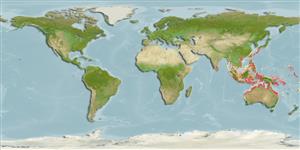Environment: milieu / climate zone / depth range / distribution range
Ecology
Marine; brackish; reef-associated; depth range 1 - 20 m (Ref. 90102). Tropical
Indo-West Pacific: Indo-Australian Archipelago. Known from the Mekong delta (Ref. 12693).
Size / Weight / Age
Maturity: Lm ? range ? - ? cm
Max length : 28.0 cm TL male/unsexed; (Ref. 90102); max. published weight: 400.00 g (Ref. 3132)
Found in coastal reefs and among mangroves, sometimes in crevices or caves (Ref. 9710). Occurs in estuaries and fairly common in the tidally influenced part of the lower Mekong (Ref. 12693). Conceals itself in mud or debris and waits for prey to come by (Ref. 12693). Feeds on crabs, prawns, mollusks, echinoderms, and fishes. Stab wounds from spines can result to severe pain. Rarely trawled. Marketed fresh in the Mekong delta (Ref. 12693).
Life cycle and mating behavior
Maturities | Reproduction | Spawnings | Egg(s) | Fecundities | Larvae
Allen, G.R. and R. Swainston, 1988. The marine fishes of north-western Australia: a field guide for anglers and divers. Western Australian Museum, Perth. 201 p. (Ref. 3132)
IUCN Red List Status (Ref. 130435)
Threat to humans
Harmless
Human uses
Tools
Special reports
Download XML
Internet sources
Estimates based on models
Preferred temperature (Ref.
123201): 24.8 - 29.3, mean 28.6 °C (based on 2393 cells).
Phylogenetic diversity index (Ref.
82804): PD
50 = 0.5625 [Uniqueness, from 0.5 = low to 2.0 = high].
Bayesian length-weight: a=0.00389 (0.00180 - 0.00842), b=3.12 (2.94 - 3.30), in cm total length, based on all LWR estimates for this body shape (Ref.
93245).
Trophic level (Ref.
69278): 3.7 ±0.56 se; based on food items.
Resilience (Ref.
120179): Medium, minimum population doubling time 1.4 - 4.4 years (Preliminary K or Fecundity.).
Fishing Vulnerability (Ref.
59153): Low vulnerability (18 of 100).
Nutrients (Ref.
124155): Calcium = 58.4 [32.1, 118.3] mg/100g; Iron = 0.535 [0.309, 0.948] mg/100g; Protein = 18.2 [17.1, 19.4] %; Omega3 = 0.11 [0.06, 0.19] g/100g; Selenium = 25 [13, 52] μg/100g; VitaminA = 113 [39, 320] μg/100g; Zinc = 1.57 [1.08, 2.18] mg/100g (wet weight);
